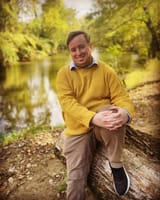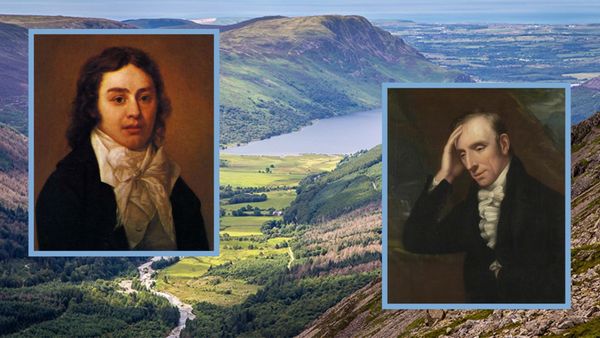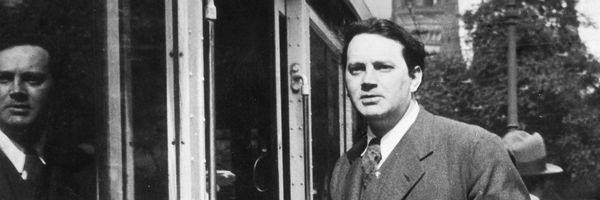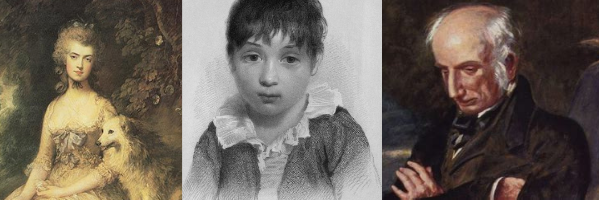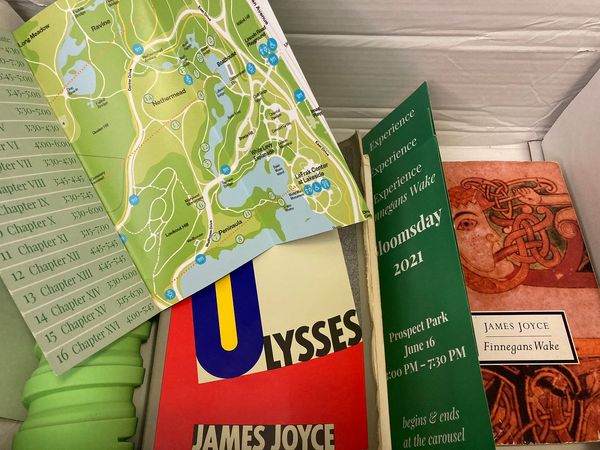Week 6: Digital Nature
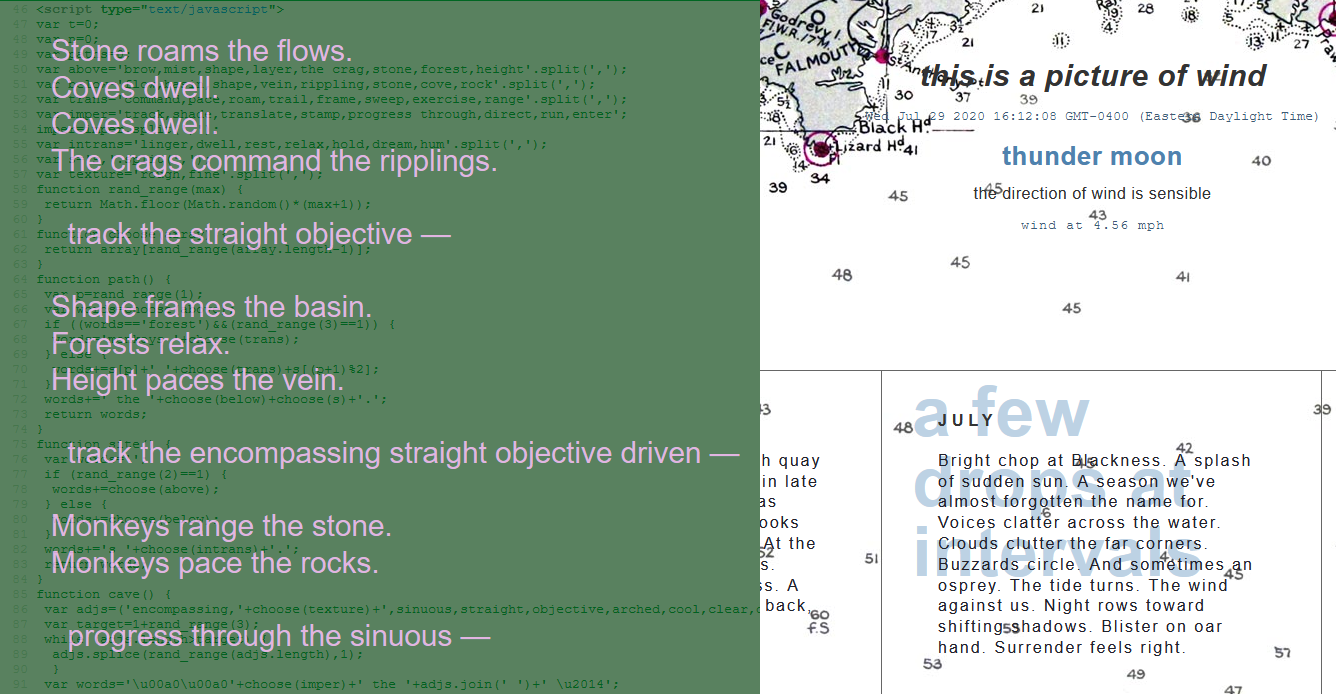
Last week, we looked at three collections of poetry. Each was the product of a single poet, with a series of short works organized around a central concept. In traditional conceptions of poetry, these are original expressive writings of these poets. The length of the average acknowledgements page in contemporary publishing stands opposed to the idea that the original genius is also a solitary genius. In another recent collection, The Sky Contains the Plans, Matthew Rohrer follows up his poems with an afterword, "All Poetry is Collaboration," in which he writes:
There is no creation out of nothing on this Earth. There's only making new thing in collaboration with other things ... And if we were more honest about our listening and our observing, we'd admit that what we're doing much of the time is collaborating ... I collaborate with the weather a lot in my poems too. I collaborate with the city. The city and the clouds and I work together on a lot of my poems.
In this recent book, Rohrer is collaborating with his dreams, writing down strange lines he finds in his half-awake state – lines he cannot always trace back to his own original creation, as opposed to an echo of something overheard or read. Rohrer does not address this context, but in our hyperconnected age, in which language and images and so on are constantly moving through us in rapid succession, such collaboration is easier than ever. If you spend several hours browsing through various text and visual feeds, then sit down to write a poem, it will be increasingly difficult to write something which is wholly your own original expression.
Some poetic practices, accordingly, borrow heavily in a very active and intentional way. Marjorie Perloff writes about this in Unoriginal Genius: Poetry by Other Means, in which she argues for recognizing new forms of inventiveness beyond simply original expression. In her introduction, she cites a suggestion from Craig Dworkin's UbuWeb Anthology of Conceptual Writing that "the test of poetry" might no longer be "whether it could have been done better ... but whether it could conceivably have been done otherwise." With consideration toward the reading text, one method of poetry which is centrally concerned with poems which could be otherwise is generative poetry.
Each generative poem has limits. How it is structure, the language it is drawing from, and the ways in which the text is framed are provided by the poet. The defining feature, however, is that the precise output of the reading text is not pre-determined or final; rather, the poet creates, borrows, or adapts an algorithm which creates variations generated during each reading. For now, we will be looking specifically at two works centered around nature to consider how this context might impact our sense of nature writing or our more general relationship to nature:
- Taroko Gorge – Nick Montfort
- This is a Picture of Wind – J.R. Carpenter
Variable Experience
Nick Montfort begins his author statement for the third Electronic Literature Collection, "Taroko Gorge originated as a Python program that I developed at Taroko Gorge National Park in Taiwan. If others could go to a place of natural beauty and write a poem about that place, why couldn't I write a poetry generator, instead?" Opening the poem, I might get lines such as:
Height ranges the rocks.
Shape frames the ripplings.
enter the arched clear dim —
Or this:
Forests roam the cove.
Coves hold.
Layers hold.
Brows pace the shape.
run the clear —
Either, or both, could be a line Montfort wrote about this place – both examples are entirely in his chosen language about the park – but both are generated upon me opening the page right now. With no distinct beginning and no ending, the poem's page endlessly generates 2-4 line strophes followed by the singular indented line, which Montfort calls a "cave" line. The beginning and ending of the strophes are "path" lines and, in the case of 3-4 line strophes, the middle line(s) are "site" lines. In the context of a national park, sites and paths are guided experiences, and the "caves" here are man-made tunnels blasted out by the Chiang Kai-shek's Nationalist Army.
Montfort uses this structure to guide our reading as well, but though he notes he was there, the poem lacks an "I" with which to frame the experience. Without that, the visual and active details of his experience become open-ended variables. Look back at the examples above. "Height ranges the rocks" or "Brows pace the shape" draw on the "above" and "below" variables for their images:
var above='brow,mist,shape,layer,the crag,stone,forest,height'.split(',');
var below='flow,basin,shape,vein,rippling,stone,cove,rock'.split(',');
While "ranges" and "pace" come from this variable list:
var trans='command,pace,roam,trail,frame,sweep,exercise,range'.split(',');
If you go through the source code, you can see all the other considerations which structure the poem, the layout of its lines, how these variables come into play, and how "brow" becomes "Brows."
For reference, consider this passage from Thomas Gray's journal, October 3rd, 1769:
In the evening walk'd alone down to the Lake by the side of Crow-Park after sunset & saw the solemn colouring of night draw on, the last gleam of sunshine fading away on the hill-tops, the deep serene of the waters, & the long shadows of the mountains thrown across them, till they nearly touch'd the hithermost shore. at distance heard the murmur of many waterfalls not audible in the day-time. wish'd for the Moon, but she was dark to me & silent, hid in her vacant interlunar cave.”
Gray (personally, actually) "walk'd," and did so "alone." He saw a specific scene, at a specific time and place. He has certain feelings about this experience, such as the sight of the sunset on the water being a "deep serene." He also has thoughts and longings of what is not directly perceptible, as he "wish'd for the Moon" which was at that time "dark to me & silent." Much of this emerges from new aesthetic frameworks regarding nature and man's relation to it, ideas which Gray was helping shape through his writing. Montfort's poem moves away from this ideal, replacing the solitary individual's experience (though not entirely, as the language is still his own) with generated lines which provide description independent of him, with the ability to describe specific scenes he himself never saw. Each reading of Taroko Gorge can always be otherwise, while the underlying park remains the same.
Like Gray working within the aesthetic vision of his day, generative poetry also provides a usable shape to writing about things such as place and experience. Montfort goes on to say in his description, "The generated text, which is produced limitlessly, is pleasing to read, perhaps, but it seems at least as enjoyable to carve into the code and shape the program to represent different experiences and ideas." The work, accordingly, has been remixed by other artists over the years, and other generative poems become sources of collaboration as well. Along the right side of Taroko Gorge, you can see a running list of poets who have adapted the source code to create new texts, which then got taken by someone else on the list, and so on.
J.R. Carpenter has been working with computers and the Internet for writing since the early 1990s, so this is not her origin point, but the collection includes a 2012 remix of Taroko Gorge she made titled Along the Briny Beach. Like looking at two sonnets, a surface glance at the two texts reveals similar structures (though Carpenter adds in overlapping lines of text and images), but the content and function of each section is radically changed.
Reading Through Weather Data, and Otherwise
One of J.R. Carpenter's more recent projects is This is a Picture of Wind: A Weather Poem for Phones. Many sections of the text are much more pre-written than Taroko Gorge, but where Montfort uses his algorithm purely to structure his own writing, Carpenter here draws in part on live weather data. Taroko Gorge can be seen as similar to a feed of a place running through many different experiences, while This is a Picture of Wind – further into the smart era (2018, vs. 2009 for the original Taroko Gorge) – incorporates existing feeds more directly.
In describing the work, Carpenter writes,
Following the news in the months after these storms, I was struck by the paradox presented by attempts to evoke through the materiality of language a force such as wind which we can only see indirectly through its affect. I began to explore weather in all its written forms.
This is, in some ways, similar to the writing from Gray. Earlier on October 3rd, he describes, "beneath you, & stretching far away to the right, the shining purity of the Lake, just ruffled by the breeze enough to shew it is alive, reflecting rocks, woods, fields, & inverted tops of mountains." The wind exists for him here primarily to emphasize the lake and the way in which it reflects the image of its surroundings. Unlike the "rocks, woods, fields, & inverted tops of mountains," the breeze is not something to behold, but part of the underlying power which enhances the scene. As with the sense of collaboration described above, "nature writing" functions less as a neutral description of an activity and more as a tradition in which to work. Carpenter, accordingly, cites many earlier writers, going back to Aristotle, and including Daniel Defoe (1704) and John Clare (1827). Aspects of Gray's picture of wind can perhaps be seen in this recent example, posted as part of the project's continual life on Twitter:
grass, stone, water, and wind. in different directions. all at once. at Gardale Scar, last evening @yorkshire_dales #thisisapictureofwind pic.twitter.com/4IO3QCv9Uh
— J.R. Carpenter (@jr_carpenter) July 28, 2020
The sense of and relationship to nature, however, has changed. Carpenter is thinking not just about this scene in itself, as a pure aesthetic encounter. The context of her writing is "catastrophic flooding in Somerset and the destruction of the seawall and rail line at Dawlish in Devon," which is leads further to the work as "attempts to call attention to climate change by picturing through variations in language the disturbances and sudden absences left in the wake of wind." Like wind, in 2013, Timothy Morton described climate change as a "hyperobject," something so vast – in space and time – that it becomes impossible for us to grasp in its entirety at once and challenges our idea of what a "thing" is. Across different forms of writing, our sense of how to translate the actions of wind into language reveals different elements of what wind is, what it does, and how we understand it.
Carpenter's weather diary re-contextualizes lines as now "a picture of wind," giving a meaning not otherwise present. The additional framing of content such as live weather data gives a shifting context that challenges finalized understanding.
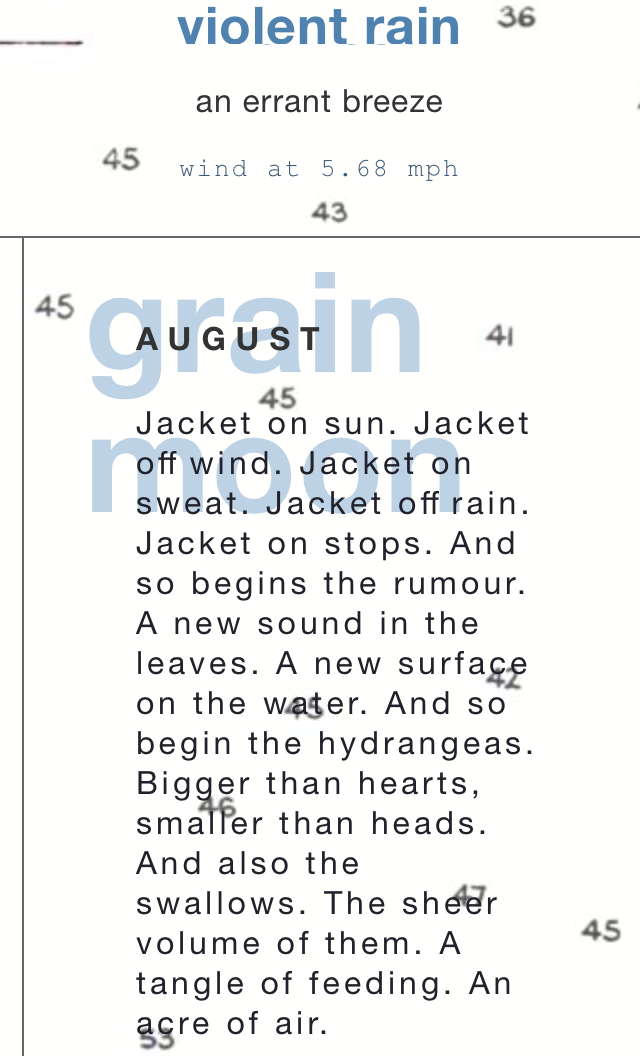
The underlying weather diary appears over an also static map image. The light blue text below shifts every few seconds, and the lines above also update. Each individual account is one depiction of the impact of wind, but these smaller pictures are brought into conversation with other pictures to create a larger rotating feed with which to grapple. While feeds, particularly on phones, are usually structured around vertical scrolling, Carpenter combines limited verticality with a primary focus on horizontal scrolling. This is revealed much more handily on desktop browser, but the work is intended primarily for phones, and so normal endless scrolling is replaced instead with interest in shifting one's gaze to the periphery.

As our gaze as readers shifts, however, the text is constantly shifting below us as well. As constructed by Carpenter, our hyperconnected experience of nature is not just the quantifiable wind speed and its corresponding categorization within the Beaufort scale, but our access to subjective description is also tossed around by our digitized tracking of the wind's forces. Just as Gray or Clare's descriptions of nature were inseparable from their aesthetic contexts, Carpenter makes our reading of the wind now inseparable from the hyperconnectivity of collective thinking, yet also at odds with the deceptive incompleteness of popular weather apps present on almost every device used for reading This is a Picture of Wind.
More recently, a print version released through Longbarrow Press offers the text in a different way. The different layers of text are broken up into different sections, displayed on their own. In a section titled "The Month Arrays," we get the lists of variables the generative text draws from to overlay within each month's cell. This is structured just as we can find it in the source code:
//January
[
"breath visible",
"brilliant mornings",
"camellia in blossom",
The section, chosen by Carpenter as the closing of her five sections in the print edition, is the only one to maintain a visible trace of the text's digital origins. As printed, "The Month Arrays" lays out the full possible range of language selected for each month, but also reminds us that we are are merely reading a list, not seeing these given to us at random as variables.
The book is thus incomplete in another way as a picture of wind. We can see the wind in glimpses, but we encounter the wind through its interplay with other things: "Mists make dangerous travel. The air loaded with freezing particles." We can also see through the "sudden absences left in the wake of wind," and might consider in a similar way the sudden absence of the weather data. We can learn to read the sections in relation to each other, or we can learn to read the texts as served to us – via Carpenter's structuring – by data streams. This context of hyperconnectivity, with its surplus of information, is not a threat to literary formulations as providing a picture of wind, but a new tool by which an artist can help us see things which we otherwise might not.
This is part of a 10-week course of study on "Literature & Hyperconnectivity." We will be joined live on Friday, August 14 (2 PM EST / 7 PM BST) by Nick Montfort and J.R. Carpenter, discussed above. We will also be joined on Saturday, September 5 (2 PM EST / 7 PM BST) by Karen An-hwei Lee and Tim Maughan. To get continued weekly updates and information on live events, sign up below.

